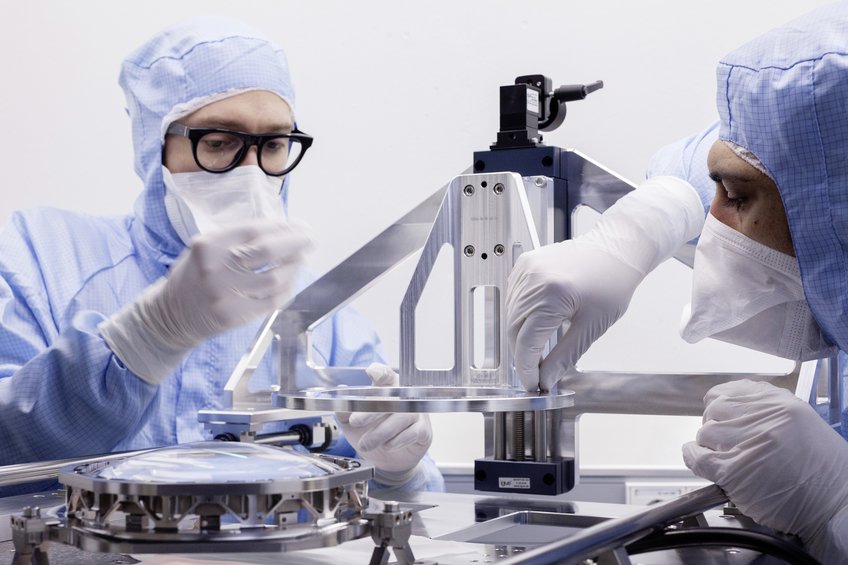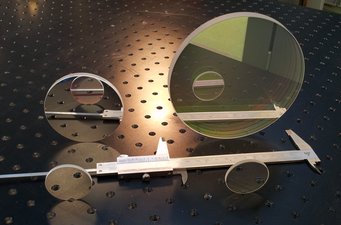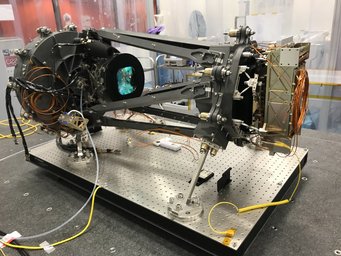The Euclid space telescope contains technology from two Max Planck Institutes
Planning a space telescope mission like Euclid allows for only one launch attempt. Researchers and engineering teams from the Max Planck Society have had to overcome major challenges to make the technology work in space. They have developed optical components and parts of the instruments on board, and are now working to ensure that the data is flawless. The possibility of encountering unforeseen issues after years of planning highlights that Euclid is pushing the boundaries of what was previously visible.

In the clean room of the Max Planck Institute for Extraterrestrial Physics, two employees of the space company OHB transfer part of the lens optics of the NIST instrument (left) to a measuring machine (right).
© Johannes Maas
Decades of research and technological development preceded the moment when the Euclid space telescope sent its first images back to Earth. Researchers and engineers from the Max Planck Institutes for Astronomy in Heidelberg and for Extraterrestrial Physics in Garching near Munich were involved. They are part of the Euclid consortium, which includes research institutes in 17 countries. They helped to develop and build the telescope’s two instruments, the optical camera (VIS, Visible Instrument) and the near-infrared camera (NISP, Near-Infrared Spectrometer and Photometer). Another team from the two Max Planck Institutes, together with colleagues from other institutions, now ensures the operation of the telescope and the logistics and quality of the data transmitted.
A unique telescope
Euclid is located behind the Earth on an imaginary axis piercing through Sun and Earth. From there, the space telescope surveys a significant portion of the visible sky, scanning for distant galaxies. Here, the Earth’s atmosphere can’t interfere, and Euclid has a clear view of the dark and diverse universe. The telescope is unique. “Together, we have developed the largest optical lens systems ever used for a scientific space mission,” says Frank Grupp, senior scientist at the Max Planck Institute for Extraterrestrial Physics and the Ludwig Maximilian University in Munich. Four lenses, up to 18 centimetres in diameter and weighing 2.5 kilograms – an unprecedented achievement in space technology.

The four infrared filters installed in the NISP instrument with diameters of four centimetres in the foreground and eight and fourteen centimetres in the background. At over 300 grams per filter, these are the largest and heaviest infrared filters ever used on an astronomical space mission. The basis of all filters is quartz glass, which is specially coated so that each filter only allows infrared light at very specific wavelengths to pass through.
© MPIA/Felix Hormut
The NISP instrument’s three colour filters are also breaking records. “They are the largest infrared filters of any astronomical space mission to date,” says Knud Jahnke of the Max Planck Institute for Astronomy, which developed the filters in collaboration with industry. Euclid’s camera plane captures an image roughly the size of the full moon and about 250 times larger than the Hubble Deep Field, a single image taken by the Hubble Space Telescope, a narrow window in which thousands of distant galaxies have been seen.
The large field of view and the large optics go hand in hand. They will be used to image almost the entire visible sky beyond our own galaxy in high resolution and detail in just six years, capturing billions of galaxies in a three-dimensional map. The aim is to answer the question of how the Universe has evolved and what role dark matter and dark energy have played in this process.
The final test

The Esa mission Euclid in the clean room of the Laboratoire d’Astrophysique de Marseille. The fully assembled NISP detector system is located on the right-hand side in the focus of the telescope. The shimmering blue lens system is clearly recognisable on the left-hand side, with the filters in the apparatus located behind the lenses. These filters are crucial, ensuring that the infrared light undergoes colour filtration before reaching the NISP instrument
© Euclid Consortium & NISP instrument team
After many years of careful assembly of the telescope’s instruments in ultra-clean conditions, Euclid lifted off on the shoulders of a Falcon 9 rocket from Cape Canaveral spaceport on 1 July 2023 with a thunderous roar. Frank Grupp remembers: “When I felt the engines in my stomach and chest, I had to think about ‘my’ lenses, which were subjected to much stronger vibrations just 60 metres away from the engines”. Nevertheless, he was confident that the optics would hold up.
“Most of the mechanics are built to withstand two minutes of launch, during which extreme forces occur,” says Knud Jahnke. The major mishaps came at the beginning of the planning phase. “Right at the beginning, a first lens design burst on the test bench. That hurt. It was light, but the material made it too brittle. We learned from that”, says Frank Grupp. “Failure is a sensitive subject, but it’s important. The lenses that went into space were heavier, but more robust. It was a compromise, because every gram of launch weight is expensive.
Success lies in the detail
Calibration scientists are needed to ensure that Euclid’s optics also produce images suitable for cosmological studies, i.e. images that are better than would ever be possible from the ground. At the Max Planck Institute for Astronomy, they mediate between the expectations of the telescope system under ideal conditions and the real conditions of the telescope in orbit during calibration. They optimise the images and data by closely studying the characteristics of the instruments and the telescope, as well as the influence of the harsh environment of space, and then taking them into account. “The instrument is what it is,” says Knud Jahnke. “I can calculate what to expect on paper in advance, but the conditions in space are slightly different from those in a laboratory on Earth.”
A three-dimensional map of the universe
After six years, Euclid will have provided about 40,000 images. To create a three-dimensional map of the galaxies in our observable universe from the two-dimensional images, ground-based telescopes will help determine the distances to the imaged galaxies. “The data from the telescopes we bring in from Earth far exceeds the volume of data from Euclid,” says Maximilian Fabricius of the Max Planck Institute for Extraterrestrial Physics and the Ludwig Maximilian University of Munich, who heads the German Euclid data centre. This includes spectroscopic data, i.e. the colour components of visible light, which can be used together with Euclid’s infrared spectra to determine the distances to the billions of galaxies.
Trust leads to safety
The first published scientific images show that the design of the telescope meets all the requirements. The Max Planck Institutes involved were part of a complex and detailed process during the telescope’s development. A space telescope like this can only be launched once and cannot be repaired afterwards. According to Knud Jahnke, the key to success lies not only in expertise, but also in fostering an open culture of error during development: “It was immensely beneficial for the mission that problems could always be discussed openly and that we always treated each other with trust”.
TB








